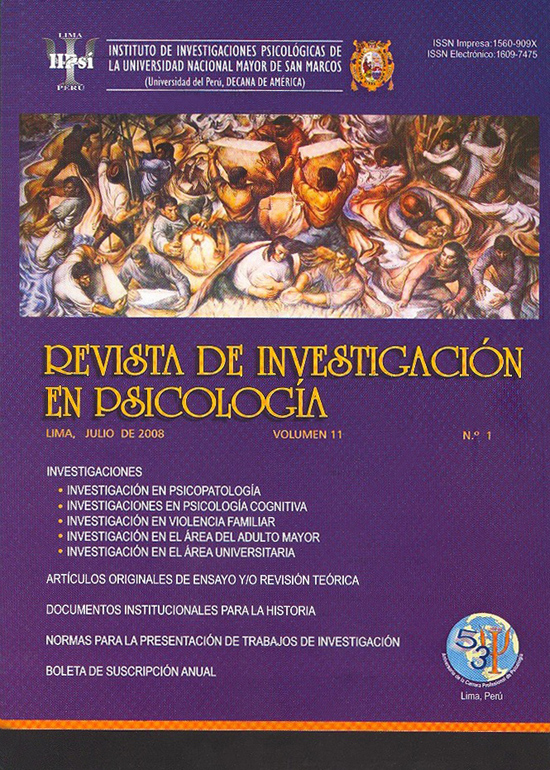Estudio psicométrico sobre el examen de admisión 2008-I a la Universidad Nacional Mayor De San Marcos
DOI:
https://doi.org/10.15381/rinvp.v11i1.3886Palabras clave:
psicometría, validez, confiabilidad, ítemes, ítem binarioResumen
En el presente estudio exploratorio de tipo descriptivo, se plantea la siguiente pregunta de investigación: ¿El examen de admisión 2008-I a la Universidad Nacional Mayor de San Marcos cumple con los requisitos psicométricos exigidos para trabajos de esta naturaleza? El objetivo general de la investigación ha sido: Diagnosticar las características psicométricas básicas que ha presentado el examen de admisión 2008-I a la Universidad Nacional Mayor de San Marcos, es decir: la confiabilidad de la prueba, la validez de los ítemes y el análisis de ítemes (índice de dificultad, poder discriminativo y eficiencia de las respuestas de distracción), respectivamente. El diseño de investigación corresponde al descriptivo simple y nos ha permitido analizar desde la perspectiva psicométrica los resultados obtenidos por los 18 588 postulantes al proceso de admisión 2008-I. El instrumento utilizado ha sido la prueba de admisión 2008-I a la UNMSM, que comprendió un total de 100 ítemes binarios o dicotómicos de tipo opción múltiple, cinco alternativas. De ese total, la mitad del examen, es decir, 50 preguntas corresponden al área de habilidades que tiene dos partes: verbal, compuesta por 25 elementos y numérica que comprende los otros 25 ítemes. La otra parte de la prueba, compuesta por 25 ítemes, comprende diversas áreas del conocimiento y es elaborada y aplicada indistintamente en relación a las diferentes especialidades que ofrece la Universidad Nacional Mayor de San Marcos. El análisis estadístico se llevó a cabo teniendo en cuenta un análisis descriptivo y exploratorio para describir de manera detallada el análisis psicométrico del examen de admisión. En la prueba de admisión 2008-I a la UNMSM, los resultados se aproximan a la distribución normal, por lo que ha sido posible trabajar con estadísticos paramétricos. Los resultados corroboran que las preguntas del examen son consistentes entre sí. El análisis de la confiabilidad por consistencia interna nos indica coeficientes alfa razonables en las seis áreas examinadas, lo que nos permite inferir la existencia de puntajes confiables. Entre las conclusiones más importantes del presente estudio tenemos: 1) La prueba de admisión 2008-I en su conjunto ha presentado una confiabilidad aceptable en las dos partes que la componen: habilidad y conocimientos. 2) El análisis de la validez de los ítemes que conforman la prueba son indicadores de que el examen mide en su conjunto lo que pretende medir. 3) Los grados de dificultad de los ítemes se concentraron en los niveles intermedio y difíciles, encontrándose un reducido grupo de preguntas estimadas fáciles. 4) El análisis de ítemes revela que las preguntas del examen han presentado mayoritariamente una discriminación positiva, es decir, los postulantes con mayores puntajes en la prueba total acertaron en los ítemes más frecuentemente que los que lograron los menores calificativos en el examen total. 5) En líneas generales, se puede afirmar que la prueba de admisión 2008-I ha cumplido satisfactoriamente con los requisitos psicométricos exigidos para exámenes de esta naturaleza.Descargas
Publicado
Número
Sección
Licencia
Derechos de autor 2008 Carlos Ponce D., Miguel Escurra M.

Esta obra está bajo una licencia internacional Creative Commons Atribución-NoComercial-CompartirIgual 4.0.
LOS AUTORES RETIENEN SUS DERECHOS:
a. Los autores retienen sus derechos de marca y patente, y tambien sobre cualquier proceso o procedimiento descrito en el artículo.
b. Los autores retienen el derecho de compartir, copiar, distribuir, ejecutar y comunicar públicamente el articulo publicado en la Revista de Investigación en Psicología (por ejemplo, colocarlo en un repositorio institucional o publicarlo en un libro), con un reconocimiento de su publicación inicial en la Revista de Investigación en Psicología.
c. Los autores retienen el derecho a hacer una posterior publicación de su trabajo, de utilizar el artículo o cualquier parte de aquel (por ejemplo: una compilación de sus trabajos, notas para conferencias, tesis, o para un libro), siempre que indiquen la fuente de publicación (autores del trabajo, revista, volumen, numero y fecha).






